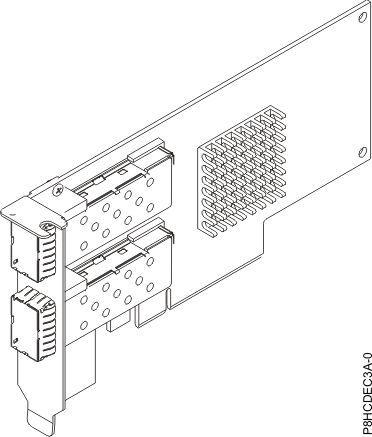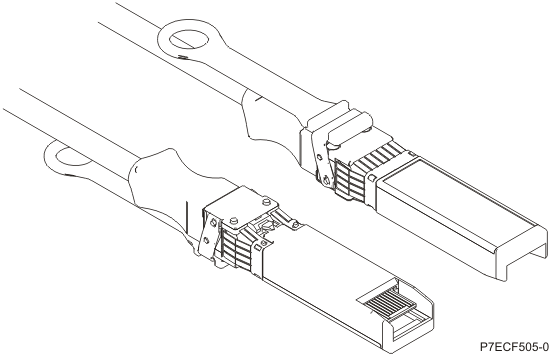PCIe3 LP 2-Port 40 GbE NIC RoCE QSFP+ Adapter (FC EC3A; CCIN 57BD)
Learn about the specifications and operating system requirements for the feature code (FC) EC3A adapter.
Overview
The PCIe3 LP 2-Port 40 GbE NIC RoCE QSFP+ Adapter is a low-profile, PCIe generation-3 (PCIe3), dual port, 40-Gigabit Ethernet (GbE) adapter with a PCIe 3.0 host bus interface. The adapter acts as a network interface controller (NIC) and uses the IBTA RDMA over Converged Ethernet (RoCE) protocols to provide efficient Remote Direct Memory Access (RDMA) services. The adapter delivers high-bandwidth and low-latency 40 GbE connectivity, reducing the load on the processor and efficiently using the memory access. This action off-loads the processor from networking tasks which improves the performance and scalability of the processor.
The adapter is optimized for enterprise data centers, high-performance computing, transaction databases, cloud computing, virtualization, storage, and other embedded environments. The adapter improves network performance by increasing available bandwidth to the processor and by providing enhanced performance. The adapter provides dedicated adapter resources and protection for virtual machines (VM). The link aggregation and failover features of the adapter are ideal for critical network applications that require redundancy and high availability.
The two 40 Gb quad (4-channel) small form-factor pluggable (QSFP+) transceiver ports are used for connectivity with other servers or switches in the network. Each QSFP+ port provides Ethernet connectivity with a nominal data rate of 40 gigabits per second (Gbps).
The adapter does not include transceivers. Use copper cables with QSFP+ 40G BASE-SR transceivers for short distances. See Cables for more information about the cables.
For details about slot priorities and placement rules, see PCIe adapter placement rules and slot priorities and select the system you are working on.
- Data center bridging support (IEEE standard version CEE)
- T11.3 FC-BB-5 FCoE
- TCP/IP stateless offload in hardware
- Traffic steering across multiple cores
- Intelligent interrupt coalescence
- Advanced Quality of Service (QoS)
- RoHS-R6 compliant
- RDMA over Ethernet using uDAPL
- 64-bit kernel environments
- multi-processor safe
- AIX® Common Data Link Interface (CDLI) compliant
- Concurrent operation of NIC and RoCE device drivers while sharing the same physical port
- Standard frames (1518 bytes + 4 bytes for VLAN tag)
- Jumbo frames (9018 bytes + 4 bytes for VLAN tag)
- IPV4 or IPV6 transmit/receive TCP checksum offload
- IPV4 transmit TCP segmentation offload (commonly known as large send)
- IPV4 receive TCP segmentation aggregation (commonly known as large receive)
- Enhanced Error Handling (EEH) from PCI bus errors
Figure 1 shows the adapter.

Specifications
- Item
- Description
- Adapter FRU number
- 00FW105 (Designed to comply with RoHS requirement)
- I/O bus architecture
- PCIe3 x8
- Slot requirement
- For details about slot priorities and placement rules, see PCIe adapter placement rules and slot priorities and select the system you are working on.
- Cables
- See Cables for details.
- Voltage
- 3.3 V
- Form factor
- Short
- Maximum number
- For details about the maximum number of adapters that are supported, see PCIe adapter placement rules and slot priorities and select the system you are working on.
Cables
This adapter feature requires the use of compatible QSFP+, 40 Gbps, copper, twinaxial, active, Ethernet cables for cabling over short distances. See Figure 2 for different views of the QSFP+ copper cable. For distances over 5 meters, use two optical QSFP+ SR transceivers (FC EB27) that attach to optical cables FC EB2J or FC EB2K. See Table 1 for details about the feature codes.
Do not mix copper and optical cables on the same adapter.

| Cable length | Feature code | CCIN | Part number |
|---|---|---|---|
| Copper cables | |||
| 1 m (3.28 ft) | EB2B | 49Y7934 | |
| 3 m (9.84 ft) | EB2H | 49Y7935 | |
| 5 m (16.4 ft) | ECBN | 00D5809 | |
| Optical cables | |||
| 10 m (32.8 ft) | EB2J | 41V2458 | |
| 30 m (98.4 ft) | EB2K | 45D6369 | |
| QSFP+ 40G BASE-SR transceiver | EB27 | 49Y7928 | |
Operating system or partition requirements
If you are installing a new feature, ensure that you have the software that is required to support the new feature and that you determine whether any prerequisites must be met for this feature and attaching devices. To check for the prerequisites, see IBM Prerequisite website.
- AIX
- AIX 7.1, or later
- AIX Version 6.1, or later
- Linux
- Red Hat Enterprise Linux Version 7, or later, with current maintenance updates available from Red Hat.
- Red Hat Enterprise Linux Version 6.5, or later, with current maintenance updates available from Red Hat.
- SUSE Linux Enterprise Server Version 12, or later
- SUSE Linux Enterprise Server 11, Service Pack 3, or later, with current maintenance updates available from SUSE.
- Ubuntu Server 14.04.3, or later
- For support details, see the Linux Alert website.
- The latest version of the device driver or iprutils can be downloaded from the IBM Service and Productivity Tools website.
- Supported on Firmware level 8.1
- PowerKVM
- IBM PowerKVM 2.1.1, or later
